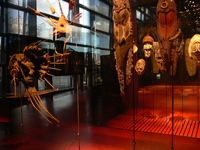Difference between revisions of "Exhibits"
m (Text replacement - "http://" to "https://") |
|||
| (One intermediate revision by the same user not shown) | |||
| Line 2: | Line 2: | ||
==Etymology== | ==Etymology== | ||
| − | [ | + | [https://nordan.daynal.org/wiki/index.php?title=English#ca._1100-1500_.09THE_MIDDLE_ENGLISH_PERIOD Middle English], from [[Latin]] exhibitus, past participle of exhibēre, from ex- + habēre to have, hold |
| − | *Date: [ | + | *Date: [https://www.wikipedia.org/wiki/15th_Century 15th century] |
==Definitions== | ==Definitions== | ||
:transitive verb | :transitive verb | ||
| Line 14: | Line 14: | ||
* to display something for public inspection | * to display something for public inspection | ||
==Description== | ==Description== | ||
| − | An '''exhibition''', in the most general sense, is an [[organized]] presentation and display of a selection of items. In [[practice]], exhibitions usually occur within [ | + | An '''exhibition''', in the most general sense, is an [[organized]] presentation and display of a selection of items. In [[practice]], exhibitions usually occur within [https://en.wikipedia.org/wiki/Museum museum]s, galleries and exhibition halls. Exhibitions include art exhibitions, as in major art museums and small art galleries; [[interpretive]] exhibitions, as at natural history museums and history museums, for example; and commercial exhibitions, or trade fairs. |
The [[word]] exhibition is usually, but not always, the word used for a collection of items. Sometimes "exhibit" is used synonymously with "exhibition," but "exhibit" generally refers to a single item being exhibited within an exhibition. | The [[word]] exhibition is usually, but not always, the word used for a collection of items. Sometimes "exhibit" is used synonymously with "exhibition," but "exhibit" generally refers to a single item being exhibited within an exhibition. | ||
| Line 20: | Line 20: | ||
Exhibitions may be permanent displays or temporary, but in common usage, "exhibitions" are considered temporary and usually scheduled to open and close on specific dates. While many exhibitions are shown in just one venue, some exhibitions are shown in multiple locations, such exhibitions are called travelling exhibitions. | Exhibitions may be permanent displays or temporary, but in common usage, "exhibitions" are considered temporary and usually scheduled to open and close on specific dates. While many exhibitions are shown in just one venue, some exhibitions are shown in multiple locations, such exhibitions are called travelling exhibitions. | ||
| − | Though exhibitions are common [[events]], the [[concept]] of an exhibition is quite wide and [[encompasses]] many [[variables]]. Exhibitions range from an extraordinarily large [[event]] such as a [ | + | Though exhibitions are common [[events]], the [[concept]] of an exhibition is quite wide and [[encompasses]] many [[variables]]. Exhibitions range from an extraordinarily large [[event]] such as a [https://en.wikipedia.org/wiki/World%27s_Fair World's Fair] exposition to small one-artist solo shows or a display of just one item. [https://en.wikipedia.org/wiki/Curator Curators] are sometimes involved as the people who select the items in an exhibition. [[Writers]] and [[editors]] are sometimes needed to write [[text]], labels and accompanying printed [[material]] such as catalogs and [[books]]. Architects, exhibition designers, graphic designers and other designers may be needed to shape the exhibition [[space]] and give [[form]] to the editorial [[content]]. |
[[Category: Art]] | [[Category: Art]] | ||
[[Category: General Reference]] | [[Category: General Reference]] | ||
Latest revision as of 01:17, 13 December 2020
Etymology
Middle English, from Latin exhibitus, past participle of exhibēre, from ex- + habēre to have, hold
- Date: 15th century
Definitions
- transitive verb
- 1 : to submit (as a document) to a court or officer in course of proceedings; also : to present or offer officially or in legal form
- 2 : to present to view: as
- a : to show or display outwardly especially by visible signs or actions <exhibited no fear>
- b : to have as a readily discernible quality or feature <in all cultures we know, men exhibit an aesthetic sense — H. J. Muller>
- c : to show publicly especially for purposes of competition or demonstration <exhibit a collection of artifacts>
- intransitive verb
- to display something for public inspection
Description
An exhibition, in the most general sense, is an organized presentation and display of a selection of items. In practice, exhibitions usually occur within museums, galleries and exhibition halls. Exhibitions include art exhibitions, as in major art museums and small art galleries; interpretive exhibitions, as at natural history museums and history museums, for example; and commercial exhibitions, or trade fairs.
The word exhibition is usually, but not always, the word used for a collection of items. Sometimes "exhibit" is used synonymously with "exhibition," but "exhibit" generally refers to a single item being exhibited within an exhibition.
Exhibitions may be permanent displays or temporary, but in common usage, "exhibitions" are considered temporary and usually scheduled to open and close on specific dates. While many exhibitions are shown in just one venue, some exhibitions are shown in multiple locations, such exhibitions are called travelling exhibitions.
Though exhibitions are common events, the concept of an exhibition is quite wide and encompasses many variables. Exhibitions range from an extraordinarily large event such as a World's Fair exposition to small one-artist solo shows or a display of just one item. Curators are sometimes involved as the people who select the items in an exhibition. Writers and editors are sometimes needed to write text, labels and accompanying printed material such as catalogs and books. Architects, exhibition designers, graphic designers and other designers may be needed to shape the exhibition space and give form to the editorial content.
